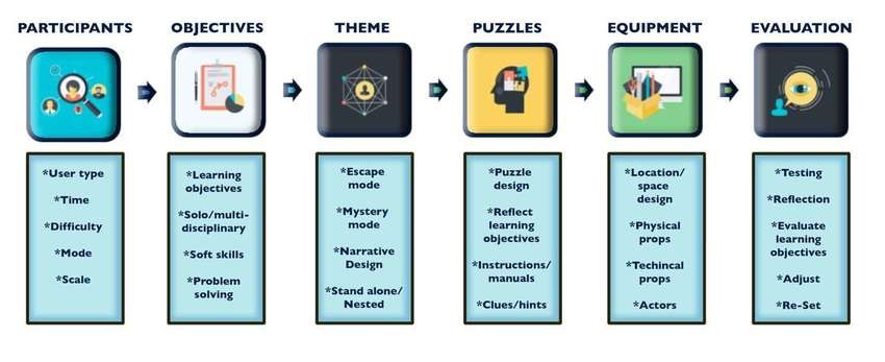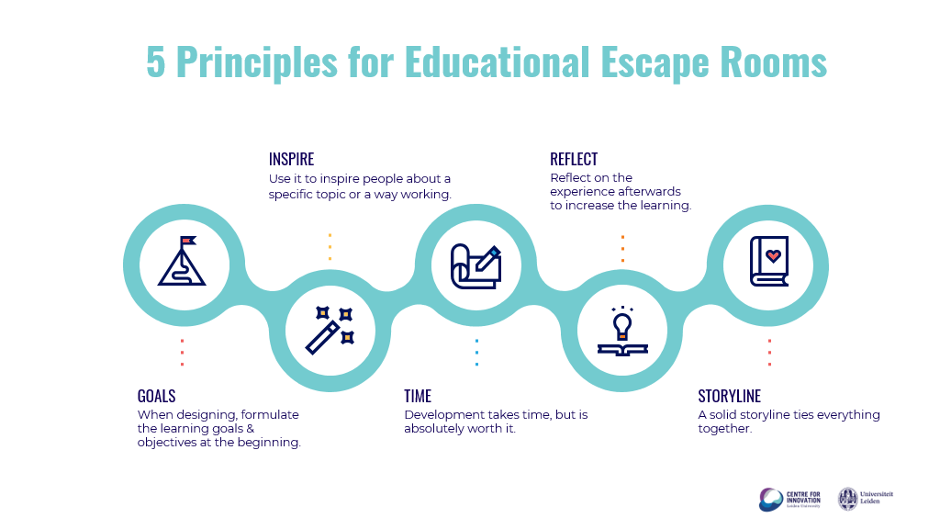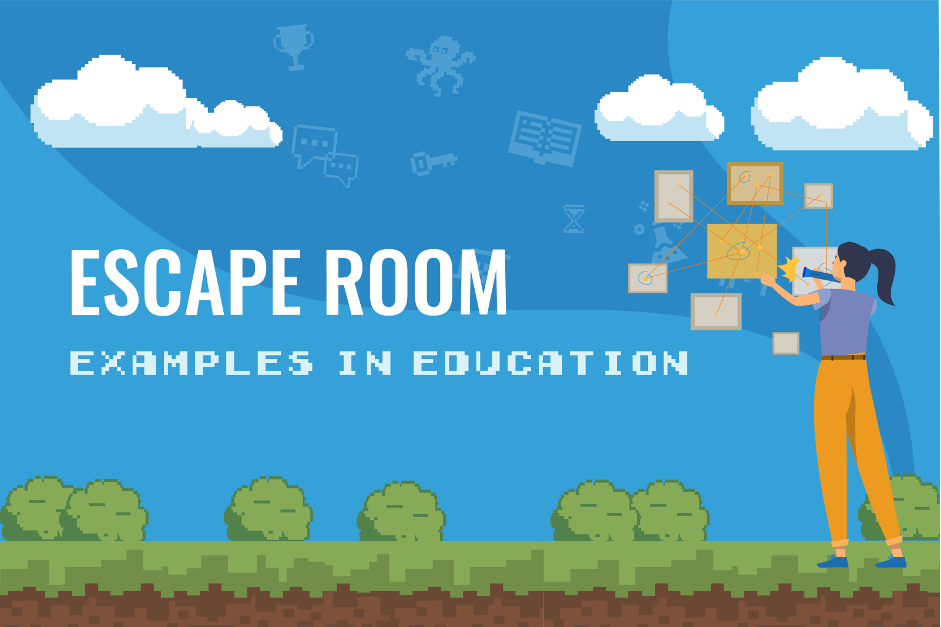Insights
Escape Room Examples in Education
Our previous article covered several examples of playful learning at Leiden University. One playful approach we haven’t touched yet is integrating escape rooms or scavenger hunts in education. In escape room games, players are locked in a physical or virtual room and must discover clues and solve puzzles to “escape” the room in a limited amount of time. They form captivating learning experiences that stimulate curiosity in learning. In this article, we interview three Dutch university innovators about their experiences with developing escape rooms and the experiences of their participants.
Escape room for Utrecht University teachers – Jasper van Winden
Utrecht University created a pop-up escape room for teachers to become acquainted with the different educational tools that are available. A pop-up escape room is location-independent and can be set up anywhere. In Utrecht’s case, the escape room has been set up at different faculties. After signing up, teachers received an email invite from a student to a kickoff meeting for his new virtual world company called “MasterMind”. Once the game starts, it turns out that the student is stuck in this virtual world. Teachers are then challenged to free the student in one hour. During this hour, teachers tackle puzzles and are provided with codes, all of which are integrated in different educational tools like FeedbackFruits and the online testing program of Utrecht University. After this hour-long escape room, teachers are asked to reflect on the experience.
Jasper, how did you design this project?
We started by writing the learning objectives. What kind of learning experience did we want our learners to have? It was very important for our goal that teachers really got to work with the actual tools themselves. We worked with a very diverse team, including people from game studies, a playwright, educational scientists, and input from the teachers themselves. Afterwards, we started the designing process with a “game-jam”, in which 40-50 teachers were asked to design puzzles. This gave us a lot of inspiration. Once the escape room was designed and teachers started to play, we asked them to fill out a survey afterwards. Unfortunately, we had some technical difficulties with the long-term survey, so we don’t know the long-term effects.
How did the teachers experience it?
Since it was a pop-up escape room, we went to the faculties and did a bit of PR beforehand. We did see that there were usually one or two excited teachers who would invite their colleagues to join. After playing, a lot of teachers were very positive about the experience. We also offered them some workshops if they wanted to know more about specific tools. The workshops increased in attendance, however, we don’t know for sure if it’s because of the escape room.
What would be your take-home message for other educational game designers?
- Create an escape room at a fixed location. Setting up the pop-up escape room in different locations took a lot of time. It would have been easier to host it at a fixed location.
- Organise a “game-jam” to do fast prototyping. This was definitely a success. It helped us connect with our target audience and get inspiration.
- Not all learning goals are suited for an escape room. However, if you have goals that are suited, make sure that your escape room is aligned with those learning goals.
- Don’t forget the pre- and postgame experience. A solid storyline helps set the stage and the reflection at the end helps to solidify the learning goals.
Escape room for Erasmus University Rotterdam teachers – Rachel Ligtvoet
The Community for Learning and Innovation (CLI) from Erasmus University Rotterdam has developed an online escape room that lets teachers experience how they can implement playful learning in their own teaching. The escape room is built in Canvas, their Learning Management System (LMS). The goal for the teachers is to motivate four unmotivated students that didn’t show up for class. Every student represents one of the four components of the Attention, Relevance, Confidence or Satisfaction (ARCS) model. The teachers need to solve puzzles to find out different strategies for student motivation. When the teachers have motivated all four students, they end with a reflection session.
Rachel, how did you design this project?
It was originally created as a physical escape room. We tested it with one pilot group, but then COVID happened so we made it into an online escape room. To create a solid educational escape room, we’ve used the escapeED framework as a methodology, which takes six main areas into account during the development process:
 The escapeED framework (source).
The escapeED framework (source).
There are two target groups: Teachers that want to learn about motivating their students and teachers that want to learn how to build an escape room. Because of the first group, we made it into a linear escape room, which means that they need to solve one puzzle to go to the next one. Only at the end of the escape room will they realize that they have gone through the four components of the ARCS model and have learned how they can motivate their students. Because of the second group, we chose to create the escape room in Canvas and use tools that teachers already use in their teaching (such as Miro), so they can easily see how they can implement playful learning in their own education. The actual learning takes place during the reflection session, when they have finished the escape room. Based on the ARCS model, the teachers must explain how they can apply what they have learned in their own teaching practices.
How did the teachers apply the lesson learned?
This project is still in its early stages. We’ve been playing the escape room for a couple of months, but we have not yet had any feedback on whether teachers have applied what has been learned. A number of teachers who finished the escape room did contact us afterwards to ask how certain tools can be implemented and whether there is a license for those tools. Ultimately, the escape room should provide teachers with inspiration.
What would be your take-home message for other educational game designers?
- Start with creating your learning goals and objectives before you decide on a theme and invent any games. Make sure that your games align with your learning goals.
- End the escape room with a reflection session. This is where the actual learning is taking place.
- Make use of available tools. Don’t let the teachers practice with educational tools that they cannot use in their own education or tools that the university does not have a license for. Make them familiar with tools that they can apply in their own teaching so the gap to implement it will be smaller.
- Take your time. It turned out to be a lot more work than we thought. We made a lot of didactical adjustments and it was a process of continuous fine-tuning and shortening.
- Create a solid recruitment campaign. It can be difficult to find teachers that want to participate. Highlight it on LinkedIn and other social media channels, put it in your mail banner, mention it at the end of other training sessions, make it free for teachers to participate, etc.
Onboarding escape room Centre for Innovation – Monika Theron
Our colleagues Monika Theron and Jelger Kroese from the Centre for Innovation have developed an onboarding escape room in Google Forms. It’s intended for new colleagues that are already a bit acquainted with the Centre. The game starts with an invitation to solve a mystery. Players start with a “get to know each other” game and divide the group into specific roles before the escape room starts. During the game, they are introduced to the city of Leiden, the office, and their colleagues.
Monika, how did you design this project?
We wanted to gamify the onboarding process. The original idea was to do a physical escape room, but then COVID happened so we put together a small team to create a digital one. We decided to use Google Forms, which took a lot more time than we had anticipated. We started with the structuring part: What do we want to do? How many locations do we want? What do we want to accomplish in each location? What are the game elements? Then we went into the researching part, which is difficult if you don’t already have the content. At last, we created the online form and found images to add to that. In the end, it turned out more like a scavenger hunt than as an online escape room. We organised multiple feedback rounds, which were very useful. The first prototype turned out to be quite difficult and competitive, causing people to be distracted. We decided to make the escape room a bit easier so it would be a fun experience with room for social interaction. We also added a bar as one of the online scenes, to help the participants snap out of the competitive mode.
How did the participants experience it?
“I had the idea that the escape room was addressing a different part of my brain. On a normal workday, I am always very focused to execute projects and solve problems. The escape room was a nice break from my normal work routine and it took me out of the rut of working from home. It was very nice to do something completely different and play a game where I felt competition and which gave me energy. It was a playful way to interact with colleagues on topics that are also relevant for work.” – Josje
“It was a lot of fun to have playful interaction with my colleagues through this treasure hunt kind of game. The fun and witty experience helped bonding with my teammates. I totally see it work not only for onboarding but also for team building.” – Leontine
“This game is a great activity for team members to get to know each other, as each player has an important role in the game, so you need teamwork to go through the tasks. I love the immersive experience, and of course the laughter with my colleagues! (One tip: Read the instruction carefully if you want to RULE the game.) ” – Bing
What would be your take-home message for other educational game designers?
- Make use of a storyline that ties all the different parts together.
- There are a lot of different ways you can implement an escape room. For example, you can change the method and use it as a test, gamify it to make it more fun or use it as a teambuilding break for your students. It really depends on the design and the message you want to get across. What do you want the person to learn at the end of the day?
- It initiates an innovation aspect that we didn’t expect, which is also the most gratifying outcome. Anyone that has played this game had an idea of how they wanted to use it.
Conclusion
The three escape room examples mentioned above are from different universities, for different users, and with a different purpose in mind. However, based on our interviews, we came up with five general principles for educational escape rooms. Do you feel like there is something missing? Let us know!

Get in touch with the authors

Yentl Croese
Learning Experience Designer
y.croese@sea.leidenuniv.nl
Emma Wiersma
Learning Experience Designer
e.m.wiersma@sea.leidenuniv.nl





